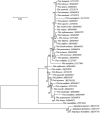The complete chloroplast genome of Vitis heyneana Roem. et Schult., an economic plant to China
- PMID: 33366647
- PMCID: PMC7748628
- DOI: 10.1080/23802359.2019.1710289
The complete chloroplast genome of Vitis heyneana Roem. et Schult., an economic plant to China
Abstract
The chloroplast (cp) genome sequence of Vitis heyneana has been characterized from Illumina pair-end sequencing. The complete cp genome was 160,830 bp in length, containing a large single-copy region (LSC) of 89,049 bp and a small single-copy region (SSC) of 19,071 bp, which were separated by a pair of 26,355 bp inverted repeat regions (IRs). The genome contained 131 genes, including 88 protein-coding genes, 37 tRNA genes, and 8 rRNA genes. The overall GC content is 37.4%, while the corresponding values of the LSC, SSC, and IR regions are 35.3, 31.7, and 43.0%, respectively. Further, the phylogenetic analysis suggested that V. heyneana was closely related to Vitis ficifolia.
Keywords: Chloroplast genome; Illumina sequencing; Vitis heyneana; phylogenetic analysis.
© 2020 The Author(s). Published by Informa UK Limited, trading as Taylor & Francis Group.
Conflict of interest statement
The authors report no conflicts of interest. The authors alone are responsible for the content and writing of this article.
Figures
References
-
- Chen XQ, Cui HB, Dai LK. 1987. Flora of China. Vol. 48. Beijing (China): Science Press.
-
- Lin L, Zhang Y, Lu J. 2005. Reach and utilization of V. heyneana, wild resource in China. Sino-Overseas Grapevine & Wine. 2:66–67.
-
- Ronquist F, Huelsenbeck JP. 2003. MrBayes 3: Bayesian phylogenetic inference under mixed models. Bioinformatics. 19(12):1572–1574. - PubMed
-
- Wu Y. 2010. Study on antioxidant capacity of Chinese wild grape and wine. Yangling (China): Northwest Agriculture and Forestry University.
LinkOut - more resources
Full Text Sources
Miscellaneous

